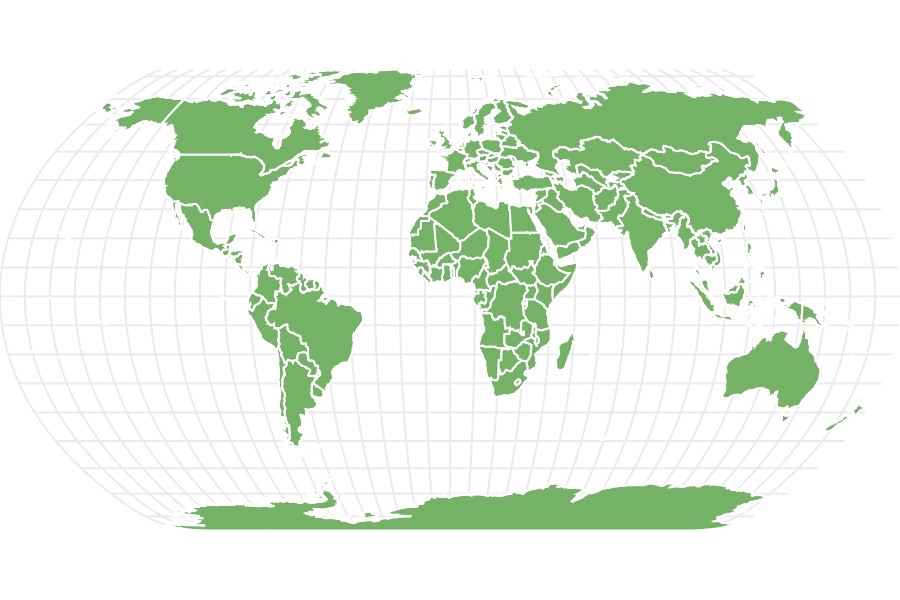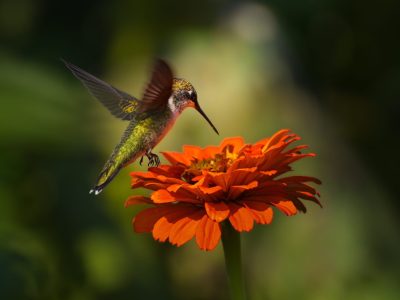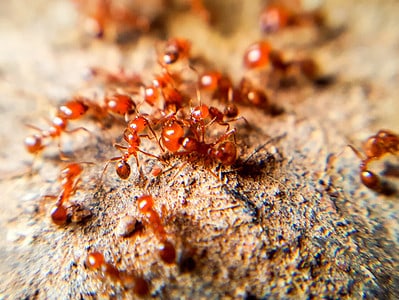Yellow-faced Bee
The genus Hylaeus contains over 500 species, making it one of the largest and most diverse groups of bees in the world.
Advertisement
Yellow-faced Bee Scientific Classification
Read our Complete Guide to Classification of Animals.
Yellow-faced Bee Conservation Status
Yellow-faced Bee Facts
- Prey
- N/A
- Main Prey
- N/A
- Name Of Young
- larvae, grubs
- Group Behavior
- Solitary
- Fun Fact
- The genus Hylaeus contains over 500 species, making it one of the largest and most diverse groups of bees in the world.
- Estimated Population Size
- Undetermined
- Biggest Threat
- Habitat loss
- Most Distinctive Feature
- colorful face
- Distinctive Feature
- lack of setae (hair)
- Other Name(s)
- masked bees
- Gestation Period
- 3-5 days
- Temperament
- docile
- Wingspan
- 0.12 to 0.31 inches (3 to 8 mm)
- Training
- N/A
- Optimum pH Level
- N/A
- Incubation Period
- 3-5 days
- Age Of Independence
- 6 weeks - 9 months
- Age Of Fledgling
- 6 weeks- 9 months (emergence)
- Average Spawn Size
- 6-12
- Litter Size
- N/A
- Habitat
- forests, deserts, grasslands, backyard gardens
- Predators
- birds, reptiles, spiders, other insects
- Diet
- Herbivore
- Average Litter Size
- N/A
- Lifestyle
- Diurnal
- Favorite Food
- Nectar
- Type
- Hylaeus
- Common Name
- Yellow-faced bee
- Special Features
- yellow face
- Origin
- Unclear
- Number Of Species
- 744
- Location
- Globally, except Antarctica
- Slogan
- N/A
- Group
- N/A
- Nesting Location
- pithy plant stems. holes or crevices in bark
- Age of Molting
- various times in larval stage
Yellow-faced Bee Physical Characteristics
- Color
- Brown
- Yellow
- Black
- White
- Tan
- Skin Type
- Exoskeleton
- Lifespan
- 3 weeks - 1 year
- Weight
- less than 1 ounce
- Height
- 0.02 inches (5 mm)
- Length
- 0.2-0.4 inches (5-11 mm)
- Age of Sexual Maturity
- 6 weeks- 9 months
- Age of Weaning
- N/A
- Venomous
- No
- Aggression
- Low
View all of the Yellow-faced Bee images!
Yellow-faced bees are small insects in the genus Hyleaus. Yellow-faced bees are found on every continent except Antarctica. They belong to the family Colletidae, which contains over 2000 species of bees! Hylaeus contains over 500 species, and North America is home to 130 species of them. They are distinctive for the yellow, white, or black markings on their faces. Because many of the species have white-to-cream-colored faces, many bee enthusiasts believe that yellow-faced bee is a misnomer. Such individuals choose to refer to species in the genus as masked bees.
Hylaeus are important pollinators, playing a crucial role in the pollination of wildflowers and agricultural crops. Unlike honey bees, they do not produce honey or live in large colonies. Yellow-faced bees make their nests in soft, pithy stems or cavities in wood. As a solitary species, yellow-faced bees do not have a worker caste. All female bees are essentially the queens of their own nests. Females of the species are solely responsible for all aspects of reproduction. From finding a mate, building a nest, constructing and provisioning brood cells, and depositing and fertilizing the eggs, she does it all. What other characteristic traits do the 500 + species of the genus Hyleaus have in common? Keep reading to find out!
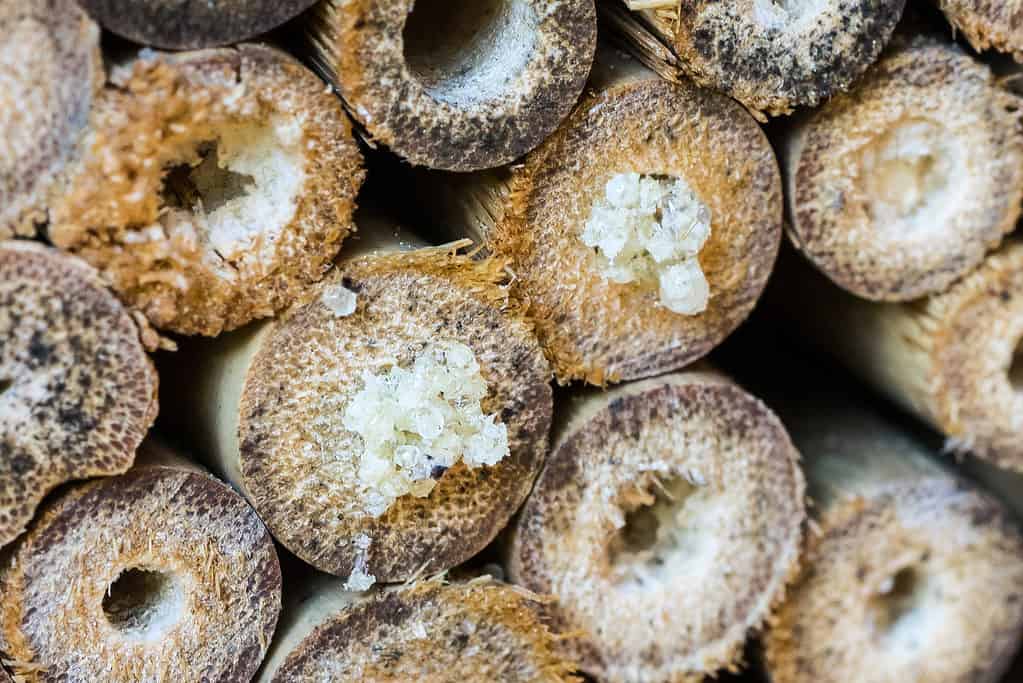
Yellow-faced bees make their nests in soft, pithy stems or cavities in wood.
©I. Rottlaender/Shutterstock.com
Five Facts about Yellow-Faced Bees
- The genus Hylaeus contains over 500 species, making it one of the largest and most diverse groups of bees in the world.
- They evolved more than 70 million years ago, making them some of the oldest known lineages of bees.
- The genus gets its name from Greek mythology, specifically from the centaur Hylaeus who was a woodsman.
- Unlike many other bee species, which form large colonies with a single queen, bees in the genus Hylaeus are solitary, with each female constructing and provisioning her own nest.
- Despite their small size, yellow-faced bees play a critical role in the pollination of many plant species, including crops, wildflowers, and trees.
Yellow-faced Bee: Scientific Name
The scientific name Hylaeus comes from the Greek word hyle, which means wood, timber, or forest. Johan Christian Fabricius (1745-1808), a student of Carl Linnaeus (1707-1778), the father of modern taxonomy, chose the name for this genus. In classical Greek mythology, Hylaeus and his brother Rhoecus were centaur woodsmen. This name is fitting for the bees in this genus, as they are often associated with woody plants, which provide habitats and food for these important pollinators.
Despite the name, bees in the genus Hylaeus are not limited to forests and woodlands and also forage in a wide range of other habitats, including deserts, grasslands, urban areas, and backyard gardens.
Appearance
Yellow-faced bees are small, They range in size from 0.2-0.4 inches (5-11 mm) in length, with a similar wingspan. of 0.12 to 0.31 inches (3 to 8 mm). They have black, nearly hairless bodies, with yellow or white markings on their faces. Males of the species are typically more colorful, but smaller than the females. Male faces are yellow or white around their eyes and lower faces. Females are notable for their devil horns, two distinct triangles of color on either side of their eyes. These bees are often mistaken for wasps because of the absence of setae (singularly, seta) on their bodies which are typical of many bee species. Setae are the bristly hairs that many species of bees use to collect pollen.
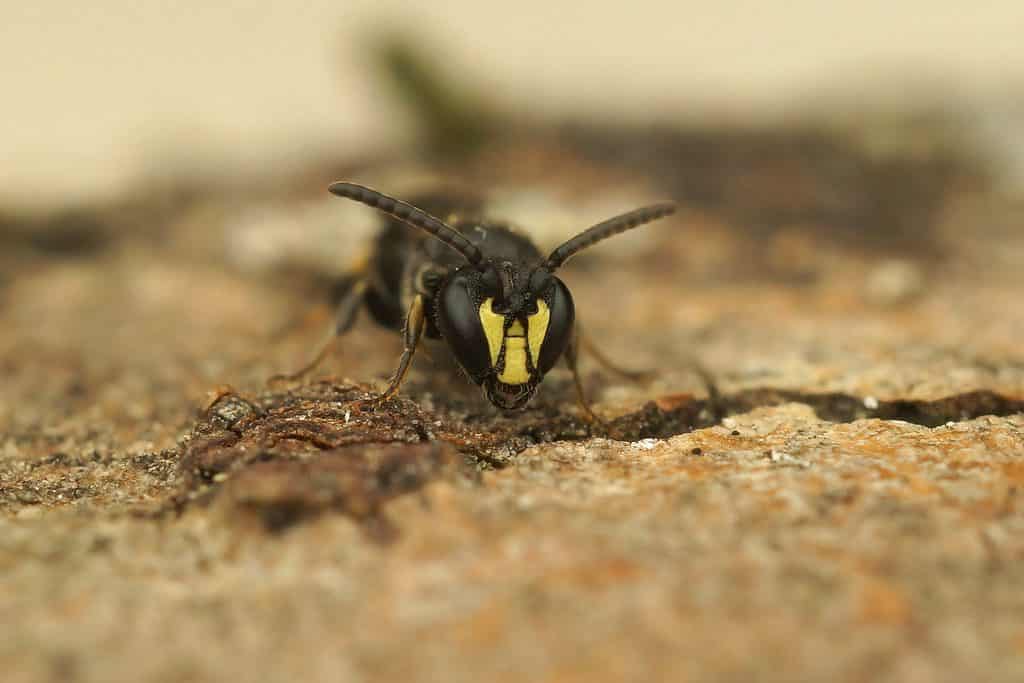
Male yellow-faced bees are marked with yellow or white around their eyes, and lower faces,
©2051664692/Shutterstock.com
Yellow-faced bees have five eyes: two compound eyes and three simple eyes, also called ocelli, plural or singularly, ocellus. Compound eyes are large, bulging eyes that cover most of the bee’s head. Ommatidia (singularly ommatidium) are the lenses that are responsible for the bees’ true vision. Compound eyes are good at detecting movement, but they have poor resolution and color vision. Simple eyes are smaller eyes located on the top of the bee’s head, between the compound eyes. They are sensitive to light and dark and are used to regulate the bee’s circadian rhythm and navigation.
Yellow-faced Bee: Behavior
General Characteristics
The one characteristic that is common to all bees in the genus Hylaeus, is their solitary behavior. They do not live in colonies like honey bees and bumblebees. As solitary bees, they do not have distinct queen, drone, and worker castes like social bees. Because each female yellow-faced bee is responsible for constructing and provisioning her own nest and laying eggs, no worker caste is necessary. Male masked bees do not have specialized worker duties and do not help with nest construction or care of the young. Females across the genus are responsible for building their nests, constructing brood cells, and provisioning the cells with nectar and pollen stores off of which her larvae will feed.
Constructing the Nest
Nesting habits across the species are highly variable and dependent on the availability of suitable nesting sites, and specific environmental conditions. Many yellow-faced bees construct their brood cells in pithy plant stems, and some others burrow into tree bark. Still, others will burrow into the ground.After she has constructed her brood cells, usually no more than 12, the female yellow-faced bee forages for the nectar and pollen with which she will fill them. Yellow-faced bees carry pollen and nectar in their crops. The crop is commonly referred to as the honey stomach. It is an organ that is used to transport nectar and pollen back to the nesting site to provision brood cells.
The female yellow-face deposits one egg in each cell, before carefully sealing the cells to protect her eggs from changes in temperature and humidity. Once the female yellow-faced bee has sealed her brood cells, depending on the specific species, she will either leave the nest never to return or hover around the nest’s entrance warding off would-be predators. Males of the genus primarily mate and forage. Yellow-faced bees are effective and important pollinators.
Habitat
Over time, the genus Hylaeus has diversified and spread, colonizing a wide range of habitats and adapting to different climatic conditions. Today, the genus includes over 500 species, with a significant portion of these occurring in Europe, Asia, and North America. Some species of yellow-faced bees will excavate their own nest sites in the stems of woody plants, while others will make use of existing holes and crevices in the bark of trees. Some species nest in the soil, in which they dig their own burrows. Despite this variability, all yellow-faced bees build individual nests. They do not live in colonies. This widespread genus lives in forests or deserts and everything in between. As long as there is a food source, these enterprising insects will find a way. Yellow-faced bees are resilient and adaptable. They are able to persist and thrive in a wide range of environments around the world.
Diet
Yellow-faced bees forage on a variety of plant species, depending on their species and the availability of food resources in its local environment. Some of the preferred plant species for foraging by masked bees include:
- Fabaceae (legume) plants such as clovers, alfalfa, and lupines
- Brassicaceae (mustard) plants such as rockcress and wallflowers
- Apiaceae (carrot) plants such as carrot, dill, and fennel
- Solanaceae (nightshade) plants such as tomatoes, peppers, and petunias
- Compositae (aster) plants such as asters, sunflowers, and daisies
These small, solitary bees are highly effective pollinators due to their behavior and anatomy. Yellow-faced bees have long, slender tongues that allow them to reach the nectar of many types of flowers, including those with long, tubular corollas. They are efficient pollinators, visiting many flowers in quick succession, and spreading pollen as they go. Hylaeus bees play a critical role in maintaining the health and diversity of their environments.
Yellow-faced Bee: Predators and Threats
Predators
Yellow-faced bees face various predators, including birds, reptiles, spiders, and other insects. Some common predators of masked bees include birds like chickadees and nuthatches. Lizards, like anoles, geckos, and skinks are opportunistic feeders that eat a wide variety of insects, including yellow-faced bees. Garter snakes, rat snakes, and king snakes will all nosh on a yellow-faced bee given the chance.
Spiders will wait near the entrance of the bees’ nests, capturing them as they emerge. Other insects, such as wasps and hornets, are also known to prey on the larvae of yellow-faced bees. Parasitic wasps will deposit their eggs in the brood cells of the bees. The wasp larvae feed on the bee larvae, to its demise.
Threats
Among the key threats facing masked bees are:
- Habitat loss: The loss of natural habitats due to deforestation, agriculture, and urbanization pose major threats to yellow-faced bees. The availability of suitable nesting sites and foraging resources declines, reducing the populations of these important pollinators.
- Pesticide exposure: The widespread use of pesticides, particularly neonicotinoid insecticides, has been shown to harm pollinators, including the yellow-faced bee. Exposure to these chemicals can reduce their ability to reproduce, reducing their chances of survival.
- Climate change: Changes in temperature and precipitation patterns affect the timing of flowering and the availability of food resources for bees.
- Pathogens: Parasites, viruses, and diseases can also harm yellow-faced bees, reducing their populations and compounding the effects of other threats.
Conservation Status and Population
Ninty-three species of Hylaeus are on the IUCN Red List of Threatened Species. Their classifications range from data deficient to near threatened. This is not surprising given the genus is so widespread, which makes it difficult to track. Populations of yellow-faced bees are not well-recorded. However, research is determining that bees across all genera are declining at an alarming rate. Therefore it would follow that the population of yellow face bees is on the decline.
Yellow-faced Bee: Lifecycle
The lifecycle of bees in the genus Hylaeus involves four stages: egg, larva, pupa, and adult. The one commonality across the genus is that adult bees tend to die off as winter approaches. However, depending on the precise species, the timing of their lifecycle stages looks very different.
Some species of Hylaeus bees have a short development time, with the eggs hatching, the larvae pupating, and emerging as adult bees within a matter of weeks. However, other species of Hylaeus bees have a longer development time and overwinter as larvae within the nest before emerging as adult bees in the spring or summer, to complete the lifecycle once again. The exact timing of development and emergence can vary depending on the species and environmental conditions.
Adult bees in the genus have very different experiences. While females are occupied with building nests and constructing and provisioning brood cells, the males of the genus solely forage and mate.
The lifespan of an adult yellow-faced bee can vary depending on the species and environmental conditions. Yellow-faced bees’ lifespans are measured in weeks and months.
Up Next:
View all 32 animals that start with YYellow-faced Bee FAQs (Frequently Asked Questions)
How many eyes do yellow-faced bees have?
Are yellow-faced bees effective pollinators?
Yellow-faced bees are effective and important pollinators. They play a critical role in the reproduction and maintenance of many plant species, not just those they feed on. They are attracted to a wide array of flowering plants, including those that provide nectar and pollen as well as those that provide nesting sites and other resources. By visiting these plants, yellow-faced bees help ensure the healthy pollination and reproduction of plant communities, which in turn provides important benefits to humans.
Are any of the over 500 species of yellow-faced bees kleptoparasites?
No! Although there are no kleptoparasitic species in the genus Hylaeus, some species of bees in the genus are hosts for parasitic species. Cuckoo bees in the genera Nomada and Sphecodes will parasitize yellow-faced bees by laying their eggs in their nests. Oftentimes when the female cuckoo invades the yellow-faced bee’s nest, she will destroy any present hose egg and larvae.
In other cases, the cuckoo bee larva hatches and consumes the provisions intended for the masked bee larva, often resulting in the death of the host larva.
Do yellow-faced bees live in colonies?
No! Yellow-faced bees are solitary bees. Bees in the genus Hylaeus do not have distinct queen, drone, and worker castes like social bees such as honey bees and bumblebees. Instead, each female yellow-faced bee is responsible for constructing and provisioning her own nest and laying eggs
Male masked bees do not have specialized worker duties and do not help with nest construction or care of the young. Instead, they spend most of their time foraging and mating.
The absence of distinct castes allows these bees to be highly adaptable and flexible in their behaviors, as each individual bee is capable of carrying out a wide range of tasks.
How long do yellow-aced bees live?
The lifespan of yellow-faced bees is species and location dependent. Some species of Hylaeus bees have a short development time, with the eggs hatching and the larvae pupating and emerging as adult bees within a matter of weeks. However, other species of Hylaeus bees have a longer development time and may overwinter as larvae within the nest before emerging as adult bees in the spring or summer. The exact timing of development and emergence can vary depending on the species and environmental conditions.
Thank you for reading! Have some feedback for us? Contact the AZ Animals editorial team.
Sources
- usda.gov, Available here: https://www.fs.usda.gov/wildflowers/pollinators/pollinator-of-the-month/yellow-faced-bee.shtml
- bugguide.net, Available here: https://bugguide.net/node/view/26461
- fws.gov, Available here: https://ecos.fws.gov/ecp/species/3398
- slverchair.com, Available here: https://watermark.silverchair.com/i0038-3872-82-1-12.pdf?token=AQECAHi208BE49Ooan9kkhW_Ercy7Dm3ZL_9Cf3qfKAc485ysgAAAtowggLWBgkqhkiG9w0BBwagggLHMIICwwIBADCCArwGCSqGSIb3DQEHATAeBglghkgBZQMEAS4wEQQM-dhEb3vGJcoI_4zNAgEQgIICjQEdGHHyJT0xpgEp6zFQnEbUJ88wwhu4vxYsb2lt0OHjJAVfn93vqOa2v0BXLXVIIPnbAU2ya71GUoEg-pD-cUTZ7N9tOm7O8n0Q5PHK-NTNhl-kPklx6fjPFTP613ZTv3sR1bqGCAtIAvQd3EoiqMyEZeW6vqLaee0UGPOOnQIUYieJiYCU_1KqZFiM0Oson0csJgYW7hwzTqR89HvbGICWPC5f9xqge8gCRlgSZwM55vr94oSq4p9jY4ZgUBAMVpqIbQfo13BNWQ8gVaGOtG-LS_xD9Xssko4TwMWPQ9HitAH6rhfFHRI8HBEwu9UuXpogR835eTOZYu7Y2U7ywOaK2rFQTYVzouzL7jmS_hIxDeVv-m4pSLtET0wW2ST-kN1jNH0wwjWzgxQ_sP2pz6H0WYVbBodoQYDW1PBmKl7f_E4y84jR6pcZwkCjZnLTmmI-jHAgsxIy5sN2CFhDl9oy4pXQ7CAUH7lJT6XBe0hok60lItfWL47qGd_EfLrut_HiLZfjTNXDdMjVqrNB6wNnLsR6iPXvMjAOBx6W4KYAwvSDSXB5wM_86G0X75Z01CwpUonRFGUWTjILW71qryH2jztrKV_bxkDWnew3w2u0wqSo0r4k5L5F1SDI3L8K4LKUq4Ze5uP2JDbp-fGFVHlYeKgfTqPqlXG8J7ZK290a3SeRo16z-S6BC9V5ZEq0x4BaW6gxlgUmITGtHkKh70Owq6rg4i5cB-lJLGAPeGuEFd5kC_98vkpIlypddX53D9W_dkj3fqNSqzFJ6PDI8UiUgkKVCyq_NHCLAxgx1Z895gyO2vLLWb1_F_UJxeV970KTYBgLCEuNQYcK8zUZqPY-HfG98neQSUlGYM7B
- animaldiversity.org, Available here: https://animaldiversity.org/accounts/Hylaeus/classification/
- umm.edu, Available here: https://apps.extension.umn.edu/environment/citizen-science/bee-atlas/bee-blocks/SpeciesDetail?speciesId=22&categoryId=1
- wikipedia.org, Available here: https://en.wikipedia.org/wiki/List_of_Hylaeus_species
- amentsoc.org, Available here: https://www.amentsoc.org/insects/glossary/terms/ommatidia/

